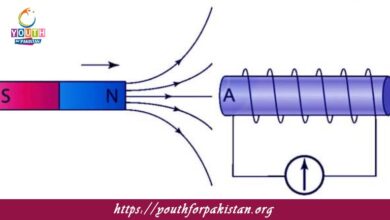Displacement MDCAT MCQs with Answers

Welcome to the Displacement MDCAT MCQs with Answers. In this post, we have shared Displacement Multiple Choice Questions and Answers for PMC MDCAT 2024. Each question in MDCAT Physics offers a chance to enhance your knowledge regarding Displacement MCQs in this MDCAT Online Test.
Displacement MDCAT MCQs Test Preparations
Displacement is defined as:
a) The total distance traveled by an object
b) The change in position of an object
c) The speed of an object
d) The average velocity of an object
If a person walks 3 km east and then 4 km north, the displacement is:
a) 5 km
b) 7 km
c) 1 km
d) 12 km
Displacement is a:
a) Scalar quantity
b) Vector quantity
c) Rate of change
d) Force
The magnitude of displacement can be found using:
a) Pythagorean theorem
b) Newton’s second law
c) Einstein’s theory
d) Conservation of energy
If an object moves from point A to point B and then returns to point A, its displacement is:
a) Zero
b) Equal to the total distance traveled
c) Half of the total distance traveled
d) The same as the distance between A and B
An object moves 5 meters north and then 5 meters south. The displacement of the object is:
a) 5 meters
b) 10 meters
c) 0 meters
d) 25 meters
Displacement is:
a) Always equal to distance
b) Independent of direction
c) A measure of how far out of the way an object has gone
d) The shortest path between two points
If a car travels 50 km east and then 30 km west, the displacement of the car is:
a) 20 km east
b) 20 km west
c) 80 km
d) 30 km
The displacement of an object in a circular path is:
a) The radius of the circle
b) The circumference of the circle
c) Zero
d) The diameter of the circle
If a person walks 10 meters north, 5 meters east, and 10 meters south, the displacement is:
a) 5 meters east
b) 15 meters
c) 10 meters
d) 10 meters south
Displacement is always:
a) Less than or equal to distance
b) Equal to distance
c) Greater than distance
d) Zero
If a ball is thrown straight up and comes back down to the starting point, its displacement is:
a) Equal to the height it reached
b) Zero
c) The total distance traveled
d) The same as the distance it fell
A person moves 2 km north and then 2 km east. The displacement of the person is:
a) 2√2 km
b) 4 km
c) 2 km
d) 4√2 km
The displacement of an object moving in a straight line at a constant speed is:
a) Zero
b) Equal to the distance traveled
c) Less than the distance traveled
d) Dependent on acceleration
If a car travels 100 km east and then 100 km back to the starting point, the displacement is:
a) 200 km
b) 100 km
c) 0 km
d) 50 km
The displacement of a particle moving in a circular path is:
a) The radius of the circle
b) The circumference of the circle
c) Zero
d) The diameter of the circle
An object moves 3 km west and then 4 km north. The resultant displacement is:
a) 5 km
b) 7 km
c) 1 km
d) 12 km
The shortest distance between two points is represented by:
a) Displacement
b) Distance
c) Path length
d) Velocity
If a person walks 6 km south and then 8 km east, their displacement is:
a) 10 km
b) 14 km
c) 8 km
d) 6 km
The magnitude of displacement is always:
a) Equal to or less than the distance traveled
b) Equal to or greater than the distance traveled
c) The same as the distance traveled
d) Zero if the distance is zero
If an object moves in a closed loop and returns to the starting point, its displacement is:
a) The length of the path
b) The radius of the path
c) Zero
d) The area enclosed by the path
The displacement vector from point A to point B is always:
a) The same as the distance
b) The shortest path from A to B
c) The total distance traveled
d) The longest path from A to B
The displacement of an object moving along a straight path with constant velocity is:
a) Zero
b) Directly proportional to time
c) Inversely proportional to time
d) Constant
A person walks 10 meters east, 5 meters north, and then 5 meters west. The displacement of the person is:
a) 10 meters east
b) 5 meters north
c) 5 meters east
d) 10 meters north
If a car moves from A to B and then from B to C in a straight line, the displacement from A to C is:
a) The sum of the distances from A to B and B to C
b) The distance from A to B plus the distance from B to C
c) The straight-line distance from A to C
d) The average of the distances from A to B and B to C
An object moves 8 meters south, then 6 meters east, and then 8 meters north. The total displacement is:
a) 6 meters east
b) 14 meters
c) 8 meters north
d) 8 meters south
Displacement can be zero if an object:
a) Moves back to its starting point
b) Is moving at constant speed
c) Changes direction constantly
d) Moves in a circular path
If a ball rolls 4 meters to the right and then 3 meters to the left, the displacement is:
a) 1 meter to the right
b) 7 meters
c) 1 meter to the left
d) 4 meters
The direction of displacement is:
a) Always the same as the direction of motion
b) The shortest path between start and end points
c) The average direction of travel
d) Perpendicular to the direction of travel
A particle moves 4 meters north and then 3 meters west. The displacement can be found using:
a) The Law of Sines
b) Pythagorean theorem
c) Newton’s laws
d) Conservation of momentum
A cyclist travels 30 km west and then 40 km east. The displacement of the cyclist is:
a) 10 km east
b) 70 km east
c) 30 km west
d) 40 km east
A person walks 20 meters north and then 10 meters south. The displacement is:
a) 10 meters north
b) 20 meters
c) 30 meters
d) 10 meters south
If a car moves from position A to position B, the displacement is:
a) The distance traveled by the car
b) The direction of travel
c) The shortest distance between A and B
d) The total distance traveled plus the direction
Displacement is affected by:
a) Only the initial and final positions
b) The total distance traveled
c) The path taken
d) The time taken to travel
An object moves 10 meters in one direction and then 10 meters in the opposite direction. The displacement is:
a) 10 meters
b) 20 meters
c) 0 meters
d) 5 meters
If a person moves 5 meters east and then 5 meters north, the displacement is:
a) 10 meters
b) 5√2 meters
c) 5 meters
d) 10√2 meters
The displacement of an object in uniform circular motion is:
a) The circumference of the circle
b) Zero
c) The radius of the circle
d) The diameter of the circle
A person walks 4 meters south, 3 meters west, and then 4 meters north. The displacement of the person is:
a) 3 meters west
b) 4 meters north
c) 4 meters south
d) 7 meters west
An object is displaced from (2,3) to (5,7). The displacement vector is:
a) (3,4)
b) (7,5)
c) (3,-4)
d) (5,7)
Displacement is measured in:
a) Meters
b) Meters per second
c) Kilograms
d) Newtons
If you are interested to enhance your knowledge regarding Physics, Chemistry, Computer, and Biology please click on the link of each category, you will be redirected to dedicated website for each category.




